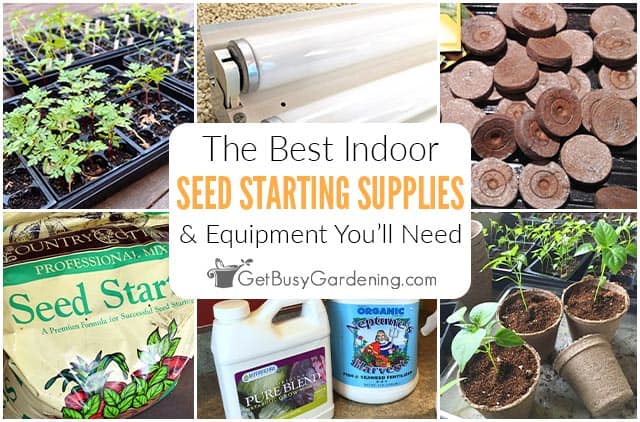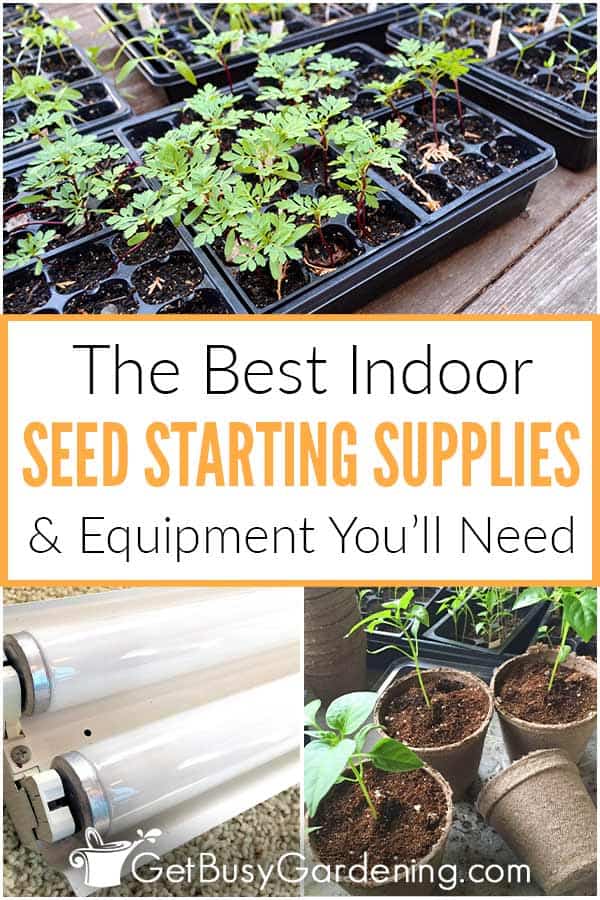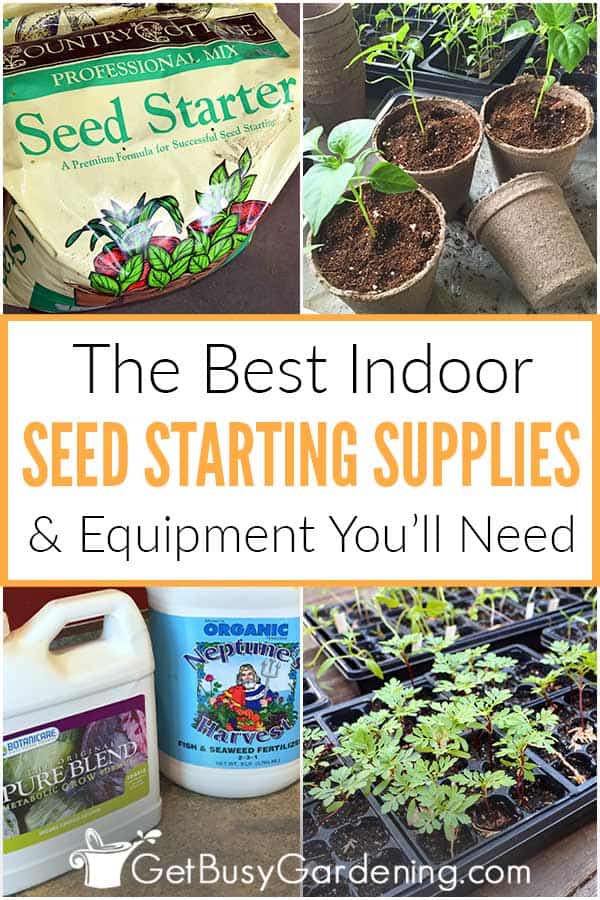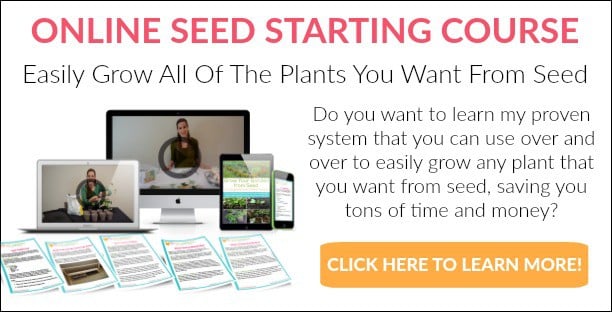Figuring out what seed starting supplies and equipment you need can be complicated. This list will show you what you need for seed starting, and also give you some optional items that will make your life much easier.

These days, there are tons of different options for seed starting supplies and equipment out there. There is so much in fact, that it can be overwhelming to figure out what you actually need.
So I thought it would be helpful to put together a list of the most important things you absolutely will need in order to grow seeds indoors.
But I didn’t stop at the essential seed starting supplies. I also included a few of my favorite optional items that you don’t necessarily need, but will make things much easier.
You don’t have to go out and buy every single piece of equipment on this list. In each section below, I give you some options for each required item, so you have several choices.
SEED STARTING SUPPLIES & EQUIPMENT LIST
Like I said above, you don’t need to buy everything on this list. But over time, you’ll need to replenish your seed starting supplies, replace broken equipment, or add more items. So you’ll definitely want to bookmark this page for later.
SEED STARTING KITS & TRAYS
One of the required items on this list, you will certainly need to get planting trays, or a starter kit of some kind. There’s no right or wrong answer here, many times it comes down to preference. Here are some great options to choose from.
1. SEED STARTING FLAT

For beginners, I highly recommend using commercial trays like this one, rather than experimenting with other types of containers. These are the basic ones that I use year after year, and can’t live without.
2. PELLET STARTER KIT

If you prefer using pellets, then you need this kit. It comes with everything you need. All you have to do is add water, and you’re ready to start planting. The tray is reusable, so you only need to buy pellet refills each year.
3. DOME KIT WITH GROW LIGHT

You can also get a more complete kit, like this one that comes with a grow light, and a nice high dome with plenty of room for seedlings. You can use this one with either pellets or plastic cells, whichever you prefer.
4. DOME KIT WITH HEAT MAT

On the other hand, if you don’t need lights, then this kit comes with a heat mat instead. Bottom heat helps to speed up germination, and it’s a huge benefit to have one of these.
5. REPLACEMENT TRAYS

In my experience, the plastic trays wear out faster than the cells and lids. Don’t worry, you don’t have to buy a whole new kit, you can buy these replacement trays instead. It’s also nice to have extras on hand, just in case one of yours springs a leak.
6. SEED STARTING CELLS

The plastic cells that come inside the tray last a long time, and can be reused for years. But sometimes you give them away, they get lost, or they break (or get stepped on – oops!). So it’s good to know the replacements are fairly inexpensive.
7. CLEAR DOME LIDS

Of course, there will also come a time when you need new lids. They will usually last the longest, since you don’t need to use them for very long. But, if yours need to be replaced, this is the standard size.
SOIL MIX & PELLETS
Another essential seed starting supply that you will for sure need to get is some kind of growing medium. You can choose to use either a soil mix or pellets. Learn how to choose which one to use here.
8. POTTING SOIL

It is very important to use a high quality mix that is specifically made for growing seeds, like this one. Don’t try to use inexpensive dirt or general purpose potting soil. Trust me, this is the one thing you do not want to go cheap on.
9. PEAT PELLETS

Plantable pellets are a great alternative to soil. They’re simple to use, with less mess. Plus, they can help reduce transplant shock, since they can be planted right into the ground. This is the standard size.
10. LARGE PELLETS

The standard pellets are great for most seeds, but can be too small for some. These bigger pellets will expand up to 3.5 inches, which is perfect for larger seeds, giving them plenty of room to grow.
DIY SOIL INGREDIENTS
If you want to make your own seed starting soil, rather than buying a mix, you’ll need a few simple supplies. Below are the ingredients and brands that I use and recommend.
11. VERMICULITE

This naturally occurring mineral helps to keep the potting mix evenly moist, improve drainage, and prevent compaction.
12. PERLITE

A lightweight amendment, perlite retains very little moisture, and prevents compaction. In other words, it helps the water drain faster, which is exactly what we want for seed starting.
13. PEAT MOSS

This additive helps the soil retain moisture longer, and also feeds the seedlings as it breaks down. It is slightly acidic though, so you’ll need to add some garden lime if you use it.
14. COCO COIR

As the by-product of coconut processing, coir is a more sustainable alternative to peat. It also holds moisture, and adds nutrients to the soil as it breaks down. Plus it’s non-acidic, so no additional additives are required.
15. GARDEN LIME

If you choose to use peat moss in your potting medium, then you’ll need to add some lime to neutralize the acidity.
GROW LIGHTS & STANDS
As you gain experience, you will most certainly find that grow lights are an essential piece of seed starting equipment. There are tons of options, and you can go as simple or as fancy as you’d like.
16. 2FT LONG FIXTURE & BULB

This super-slim fixture includes a full-spectrum T5 lamp, built-in timer, and hanging hardware. The width is just right for hanging on shelves, or inside of a mini indoor greenhouse.
17. 18″ FIXTURE & BULB

If you’re looking for a larger light fixture, this one is the same as the one above, only a few inches longer. It also includes the T5 bulb, hanging hardware, and built-in timer.
18. 2FT LIGHTING SYSTEM

For those of you looking for a more complete system, this is a great one. It’s 2 feet wide, which is perfect for a couple of flats. Plus it’s very easy to adjust the height of the light, and you don’t need any other special equipment to use it.
19. 4FT LIGHTING SYSTEM

Want an even larger seed starting system? This 4 foot grow light system has all the same features as the one above, but you can fit more trays underneath it.
20. ADJUSTABLE LIGHT HANGERS

If you want to make it simple to move your lights up as the seedlings get taller, you need to get these adjustable hangers. They’re not required, but certainly make life much easier.
21. OUTLET TIMER

When you plug your lights into a timer like this one, you can just set it and forget it! This is by far the best way to ensure your seedlings get enough light, and on the same schedule every day.
ORGANIC FERTILIZERS
It might not seem like fertilizer would be a required seed starting supply, but I highly recommend using it. Seedlings love being fed with a rich, organic plant food, and you will really notice a difference.
22. STARTER PLANT FOOD

It’s important to feed seedlings with a gentle fertilizer to avoid burning or damaging the delicate baby plants. This one is specifically made for safely feeding your starts.
23. PURE BLEND TEA

Compost tea is a very good and gentle natural fertilizer. This one comes in a concentrate. So you can make it weaker for brand new starts, then increase the strength as the seedlings get bigger. If you prefer, you could buy tea bags to brew your own.
24. FAST START FERTILIZER

This is another great one that is specifically made for seeds and seedlings. It’s granular rather than liquid, so you can add it to the soil, or pour it into the hole at planting time.
25. FISH EMULSION

Another great fertilizer that comes in a liquid concentrate, and trust me, seedlings love fish emulsion. Though you certainly could use this indoors, you might want to save this one for outside, because it can be a little stinky.
POTS FOR SEEDLINGS
Once your starts outgrow the seed trays, then you’ll need to add some containers to your equipment stash. You have two basic options here, plantable or plastic pots, depending on your preference.
27. COCO COIR POTS

If you’re worried about the sustainability of peat, then coco coir plantable pots are the solution. This is the 3″ size, or the 2″ size for your smaller seedlings.
28. PLASTIC NURSERY POTS

If you want something that’s reusable, then I recommend getting a nice set of plastic nursery pots. These will last for many years, are easy to clean, and they don’t take up much space in storage.
PLANT TAGS
While plant tags could be considered optional seed starting supplies, I find them essential. Unless you have a photographic memory (I do NOT), then you’ll need to mark your trays so you know what’s growing in there.
29. 4 INCH TAGS

This size is my favorite to use inside of my trays because they fit underneath the standard height lids. They are also reusable, so make sure to keep them for next year.
30. 6 INCH PLASTIC TAGS

These longer plant tags are nice to use once you pot up your seedlings, or if you have a higher dome lid on your trays. You can also use them in the garden.
31. RAINBOW VARIETY PACK

If you don’t want to take the time to write on all of your tags, color code them instead! This way, you can just use one color for every type of seed, and keep a reusable chart so you know what’s what.
OTHER SEED STARTING SUPPLIES & EQUIPMENT (OPTIONAL STUFF)
Now that we got the essentials out of the way, let’s talk about other seed starting supplies. These aren’t necessarily required, but will help to make things a whole lot easier for you.
32. HEAT MAT

Adding bottom heat under your trays will speed up germination, and also keep your seedlings toasty warm. A heat mat is definitely a must for seasoned growers.
33. SPRAY BOTTLE

Humidity is very important for germination, and misting your seedlings is a great way to give them the moisture they need to stay healthy. This spray bottle is also good for watering those tiny starts.
34. HUMIDIFIER

If you don’t want to bother with spraying water, use a humidifier instead. Heating your house during the winter sucks the humidity out of the air, and your seedlings will be much happier with the consistently added moisture.
35. INDOOR HUMIDITY MONITOR

With this inexpensive monitor, you’ll be able to keep track of both the humidity level and the temperature indoors. That way, you can easily make any necessary adjustments to keep your seedlings thriving.
36. SOIL MOISTURE GAUGE

Inconsistent watering is the number one cause of seedling death, and it can be difficult to get it just right. So, if you struggle with watering, I highly recommend getting one of these.
37. TABLE-TOP POTTING TRAY

This potting tray contains the mess indoors, and I love it for filling my trays, or potting my seedlings. It’s portable too, so you could even use it for transporting your starts, or moving them outside.
38. MINI GREENHOUSE

Once you have one of these, you’ll wonder how you ever lived without it. You can fit two trays on each shelf, and hang the lights right over the top. The plastic cover is easy to vent or remove, and allows you to control both the humidity and temperature.
SUPPLIES FOR KEEPING LEFTOVER SEEDS FRESH
As you probably know, you hardly ever plant every seed that comes in a packet. There are always leftovers. Below is a list of different containers you can use for keeping them fresh.
39. PACKET ORGANIZER BOX

This cute garden themed wooden box is nice for organizing leftover packets, so they are ready to go when it comes time for planting next year. It’s made of cedar, which also helps to keep them fresh longer.
40. RECIPE BOX

You can use a recipe box to store your packets alphabetically. They fit perfectly into a standard sized recipe box. This one is both nice looking and durable.
41. SEED KEEPER

This binder is specifically made for keeping seed packets nice and organized. It would fit well on a bookshelf, and even has pages where you can write down details of each packet for tracking purposes.
42. CLEAR SHOE BOX

I prefer to put my leftovers in a clear plastic shoe box. I like these because they stack neatly, and fit on the shelf in my basement closet. I can also fit larger envelopes or baggies into these, not just the regular sized packets.
43. SMALL ENVELOPES

These small envelopes are the perfect size for leftover seeds. Use them if you lost the original packet, or for sharing your extras with friends. They’re also nice for giving as gifts.
Up Next: Learn exactly how to grow all of your seeds in this detailed guide.
This list of seed starting supplies and equipment will give you all you need to get up and running quickly. As you become more experienced, you can get even more of these items to make things faster and more efficient.
If you’re tired of trying to figure out how to grow seeds by trial and error, then my Seed Starting Course is exactly what you need! It’s a fun, self-paced course that will walk you through everything you need to be successful, step by step. Sign up and get started right away!
On the other hand, if you just need a refresher to get you going, then download my Starting Seeds Indoors eBook. It’s a quick-start guide that have you up and running in no time.
More About Growing Seeds
- Lighting For Seedlings: When To Put Seedlings Under Light & How Much
- 17 Easiest Seeds To Direct Sow
- When To Start Seeds Indoors
- 17 Easiest Seeds To Start Indoors
- Easy DIY Newspaper Seed Starting Pots
What seed starting supplies and equipment would you add to this list? Share your must-haves in the comments below.







Leave a Reply